Undercut rocks, broaching rocks
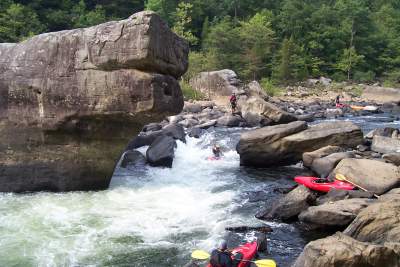 Sieves & Undercuts - Avoid these river features whether in your boat or not. Rescue can be quite challenging when a boat gets caught in one of these. Here is a great explanation on what a sieve is from Initiation Rapid on the Upper Gauley: Sieve. Undercut rocks are also pretty common on advanced runs. Here is a nice example of an undercut called Shipwreck Rock on the Upper Gauley.
Sieves & Undercuts - Avoid these river features whether in your boat or not. Rescue can be quite challenging when a boat gets caught in one of these. Here is a great explanation on what a sieve is from Initiation Rapid on the Upper Gauley: Sieve. Undercut rocks are also pretty common on advanced runs. Here is a nice example of an undercut called Shipwreck Rock on the Upper Gauley.
Undercuts can be very dangerous as we will discuss in this article. Undercut rock formations are often quite irregular and may capture river debris like trees, branches, and manmade objects. Either way if you are in your boat or out of your boat, passing through an undercut rock is a crap shoot. Seldom can you see under the water surface and what you don't see can be very deadly indeed. Since undercuts are typically in rapids the force of water can be really strong as well. Undercut rocks are created where the water is most forceful like the outside of bends, waterfalls and high ledges, and sometimes in mid-current like the clam shell formation on Railroad Rapid on the New River Gorge.
Rescuing a paddler trapped in an undercut is very challenging as well. If you are lucky, you can get a rope to the victim while they are still upright. Even in those situations, you will often need to pull them back out against the same fast moving water they swept them there in the first place. Sometimes vertical rescue techniques are required and they take considerable time to safely set up.
The best way to avoid these hazards is to research your planned run in guide books and the AW River Database. Another good source is asking paddlers that have been down this run before. Many undercuts provide some clues if you scout from shore, walk to the end of the rapid, and look back upstream. If you have a large boulder and water isn't pillowing on the upstream side as well as a very weak eddy on the downstream side - stay away! This is a tell tale undercut formation. There isn't any water pressure forming the pillow because the water is leaking out from underneath.
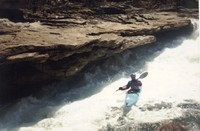 When running streams that have a sharp rock wall bend, angle your boat away from the wall. Water over time will undercut the rock wall, See example on the right. Once again if the wall is undercut, water is less likely to rise against the wall since it can escape underneath.
When running streams that have a sharp rock wall bend, angle your boat away from the wall. Water over time will undercut the rock wall, See example on the right. Once again if the wall is undercut, water is less likely to rise against the wall since it can escape underneath.
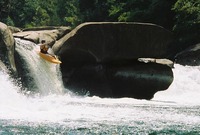 Waterfalls often form a double boil line at their curtain. The backside of the curtain gets carved away overtime forming an undercut. Notice how this waterfall is carved out on the kayakers right side. Rescues from this position are also quite tricky since it is hard to get a rope to the victim.
Waterfalls often form a double boil line at their curtain. The backside of the curtain gets carved away overtime forming an undercut. Notice how this waterfall is carved out on the kayakers right side. Rescues from this position are also quite tricky since it is hard to get a rope to the victim.
We will demonstrate a very deceptive undercut rock at the bottom of the Z Channel rapid using a throw rope.
Horizon lines
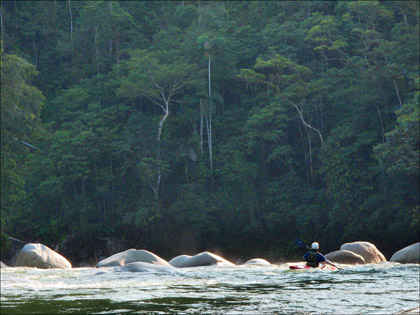 A horizon line often denotes the beginning of a steep drop or ledge. If the rapid is known to be safe, I like to cautiously paddle to the middle of the river to get a better look. You can use your back ferry or draw strokes to move laterally to line up for the best position to start the drop. If you can find an eddy close to the ledge, go catch it and get a better look from your boat.
A horizon line often denotes the beginning of a steep drop or ledge. If the rapid is known to be safe, I like to cautiously paddle to the middle of the river to get a better look. You can use your back ferry or draw strokes to move laterally to line up for the best position to start the drop. If you can find an eddy close to the ledge, go catch it and get a better look from your boat.
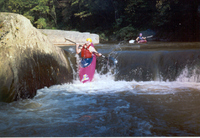 Snap Falls Large ledges typically have a distinct horizon line that precedes them. You can often identify a large ledge by looking at trees below, listening for the loud sound of crashing water, or watching the boater in front of you suddenly disappear. You may encounter ledges in class II and more difficult rapids. A great class II ledge in our area is Snap Falls on Muddy Creek - see picture on the right. On smaller ledges, boaters below will identify when it is safe to run by holding their paddle vertically. On more challenging ledges or those with potential dangers, we typically set suitable safety. When running ledges, avoid the "Old School" habit of holding the paddle shaft above your head and leaning way back. This takes your paddle out of the safe zone - the paddlers box. Leaning on the back of your boat also makes the boat less stable when you land. A better approach is to enter with a little bit of extra speed, plant a very strong last stroke at the lip, and try to lift the front of your boat with both knees. This maneuver definitely takes some practice.
Snap Falls Large ledges typically have a distinct horizon line that precedes them. You can often identify a large ledge by looking at trees below, listening for the loud sound of crashing water, or watching the boater in front of you suddenly disappear. You may encounter ledges in class II and more difficult rapids. A great class II ledge in our area is Snap Falls on Muddy Creek - see picture on the right. On smaller ledges, boaters below will identify when it is safe to run by holding their paddle vertically. On more challenging ledges or those with potential dangers, we typically set suitable safety. When running ledges, avoid the "Old School" habit of holding the paddle shaft above your head and leaning way back. This takes your paddle out of the safe zone - the paddlers box. Leaning on the back of your boat also makes the boat less stable when you land. A better approach is to enter with a little bit of extra speed, plant a very strong last stroke at the lip, and try to lift the front of your boat with both knees. This maneuver definitely takes some practice.
Strainers
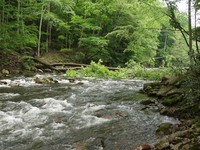 Strainers are usually downed trees or a collection of branches and trash. Do whatever you can to avoid these death traps. If you accidentally swim into a strainer, work very hard to climb up on the structure rather than getting impaled or strained by hidden limbs. Here is an example of one on the Savage River in Maryland. This is one place where the defensive swimming technique will fail and you will be swept under. If you can't avoid a strained, swim head first and quickly towards the strainer. When you reach the strainer, push yourself over the branch and kick your feet to help push you over. This video of the LA County life guard training shows how challenging swimming over strainers and why we practice the strainer drill: Strainer Drill.
Strainers are usually downed trees or a collection of branches and trash. Do whatever you can to avoid these death traps. If you accidentally swim into a strainer, work very hard to climb up on the structure rather than getting impaled or strained by hidden limbs. Here is an example of one on the Savage River in Maryland. This is one place where the defensive swimming technique will fail and you will be swept under. If you can't avoid a strained, swim head first and quickly towards the strainer. When you reach the strainer, push yourself over the branch and kick your feet to help push you over. This video of the LA County life guard training shows how challenging swimming over strainers and why we practice the strainer drill: Strainer Drill.
Hydraulics
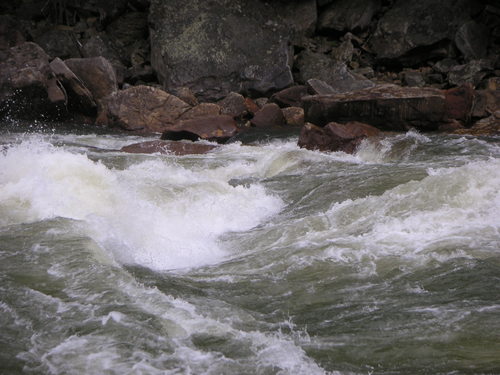 Holes (AKA: Souse Holes, Hydraulics) - A hole is caused by a depression in the river bed like water flowing over a boulder. Water cascades over the boulder (or ledge) forcefully downstream and water from downstream flows back upstream to fill in the depression. We often refer to holes as Smiles or Frowns. If the ends are out flowing downstream (Smile), you can exit the hole on either end. If the ends are facing upstream (Frown), exiting the hole isn't as easy. Upstream ended holes typically have a jet stream underwater that you can catch with your paddle or body to forcefully pull you down and out. A perfectly uniform hole - straight across like one formed by a dam can be very difficult to escape and often requires assistance. Smaller holes are often used like eddies by advanced paddlers. Play boaters (and squirt boaters) love holes as this feature enables the many tricks they like to perform. Here is an example from the Cheat River.
Holes (AKA: Souse Holes, Hydraulics) - A hole is caused by a depression in the river bed like water flowing over a boulder. Water cascades over the boulder (or ledge) forcefully downstream and water from downstream flows back upstream to fill in the depression. We often refer to holes as Smiles or Frowns. If the ends are out flowing downstream (Smile), you can exit the hole on either end. If the ends are facing upstream (Frown), exiting the hole isn't as easy. Upstream ended holes typically have a jet stream underwater that you can catch with your paddle or body to forcefully pull you down and out. A perfectly uniform hole - straight across like one formed by a dam can be very difficult to escape and often requires assistance. Smaller holes are often used like eddies by advanced paddlers. Play boaters (and squirt boaters) love holes as this feature enables the many tricks they like to perform. Here is an example from the Cheat River.
Holes, reversals, souse holes, and stoppers are synonyms. They are formed when water drops over a ledge or boulder and the water downstream of the obstacle rushes back up stream to fill in the void. When you first start paddling, you want to avoid these features. As you gain more skills and become an advanced paddler, you will often use holes as eddy alternatives, for play time, or for quickly crossing a river. Holes come in all shapes and sizes and are sometimes quite challenging to read. River wide holes that are perfectly uniform are typically created by a manmade structure like a dam - these should almost always be avoided as they can be death traps. Here is a video of Swimmers Hole on the Lower Yough: Lower Yough Swimmers Hole
Page 2 of 4
